

Audio Projects › Hi-Fi Preamp. PassDiy. Wayne Colburn Introduction Here is the long awaited sequel to the Pearl phono stage, named after my maternal Grandmother who was good with a sling shot , played piano and organ and occasionally listened to my early Hi-fi efforts if the smoke wasn't too bad.
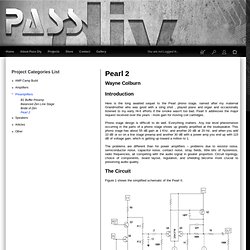
Pearl II addresses the major request received over the years - more gain for moving coil cartridges. Phono stage design is difficult to do well. Everything matters. The problems are different than for power amplifiers – problems due to resistor noise, semiconductor noise, capacitor noise, contact noise, stray fields, little bits of hysteresis, radio frequencies, all competing with the audio signal in greater proportion. PassDiy. Nelson Pass Introduction The popularity of the Zen projects points out the interest in very simple linear circuits.
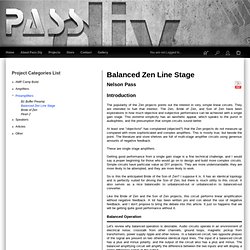
They are intended to fuel that interest. The Zen, Bride of Zen, and Son of Zen have been explorations in how much objective and subjective performance can be achieved with a single gain stage. This extreme simplicity has an aesthetic appeal, which speaks to the purist in audiophiles, and the presumption that simple circuits sound better. At least one "objectivist" has complained (objected?) These are single stage amplifiers. Getting good performance from a single gain stage is a fine technical challenge, and I would say a proper beginning for those who would go on to design and build more complex circuits. So is this the anticipated Bride of the Son of Zen? Like the Bride of Zen and the Son of Zen projects, this circuit performs linear amplification without negative feedback.
Balanced Operation. Sjöström Audio - UBC01 Audio Balanced Driver. Click on the picture to get a larger view.
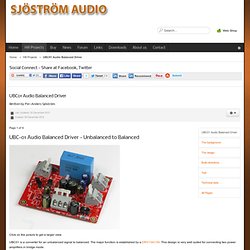
UBC01 is a converter for an unbalanced signal to balanced. The major function is established by a DRV134/135. This design is very well suited for connecting two power amplifiers in bridge mode. Interesting features 2-layer pcb with 35 um copper.Gold pads.Extremely low distortion.High common mode output impedance.Low and adjustable differential mode output impedance.Option for DIL08 or SO08 DRV134/135 .Several types of input coupling capacitors, high performance RIFA PHE426 polypropylene or 5 mm/ 0.2" caps such as polyester or other types with the same footprint, or some other type with pin spacing from 15 to 27.5 mm.On-board regulators of LM317/337 typeDiscrete regulators for using higher voltage than the max supply voltage of the LM317/337.
Sjöström Audio - QSXM3 The extreme phono (RIAA) amplifier. Click on the picture to get a larger view.
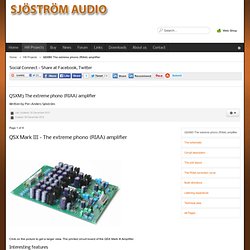
The printed circuit board of the QSX Mark III Amplifier. In order to get an extremely linear and extremely low distortion design I have taken a couple of measures: No capacitors in the signal pathsTotally DC-coupled together with DC-servoThe opamp is biased into class A with a JFET or bipolar transistor.Many decoupling capacitors and EMI-filtersPowerful output buffer, intergrated or discrete, your choice.Power supply on the board, just add AC voltage.Professional quality printed circuit board with groundplane.The pcb has lot's of possibilities when it comes to tweaking.
Potentiometers (Beginners' Guide to Pots) Copyright © 2001 - Rod Elliott (ESP) Page Created 22 Jan 2002 Articles Index Main Index Contents Introduction The humble potentiometer (or pot, as it is more commonly known) is a simple electro-mechanical transducer.
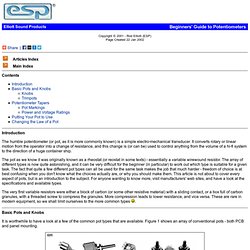
The pot as we know it was originally known as a rheostat (or reostat in some texts) - essentially a variable wirewound resistor. The very first variable resistors were either a block of carbon (or some other resistive material) with a sliding contact, or a box full of carbon granules, with a threaded screw to compress the granules. Basic Pots and Knobs It is worthwhile to have a look at a few of the common pot types that are available. Figure 1 - Some Examples of Pots Note that these are not to scale, although the relative sizes are passably close. The remainder show a few of the many variations available. Most rotary pots have 270 degrees of rotation from one extreme to the other. ) Well, as they say ... KnobsBefore we look at other pot types, a quick sample of knobs.
Handcrafted audio gear for music lovers. Pedja Rogic Audio Pages - Chip Based Power Amp i.e. Gainclone. R2 is set to provide 5-6mA bias.
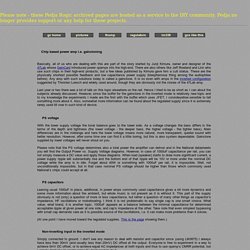
R3 (470-1k) is optional; use it if the buffer oscillates at the lowest volume levels. Two recommended LPF combinations are: (1) R1=75 Ohms, C1=47nF, C2 is omitted; (2) R1=1kOhms, C1=4.7nF, C2=33nF. The buffer circuit above is the one I settled on after a few months experimenting with it. I ran it at higher currents but ultimately the fact it is more natural at some 5-6mA (this applies to the 2SK170BL) was most important to my ears. As a current source (J2) I used J310 with R2=270 Ohms (which applies to the J310 I have; since Idss varies, better use higher value for the start). In my case the buffers are hooked to the same supply as the power chips. Considering a low pass filter, there are three options for R1: to omit it, to use lower value (75R) and to use higher value (1k).
If any doubts: the point of low pass filtering is not in change of the frequency response inside the audio band, this is unwanted consequence. . © Pedja Rogic, April - September 2003. DIY audio balanced preamp. Decibel Dungeon DIY hi-fi index.